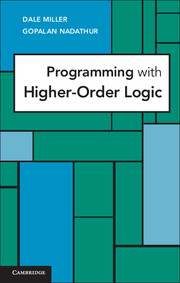Book contents
- Frontmatter
- Contents
- Preface
- Introduction
- 1 First-Order Terms and Representations of Data
- 2 First-Order Horn Clauses
- 3 First-Order Hereditary Harrop Formulas
- 4 Typed λ-Terms and Formulas
- 5 Using Quantification at Higher-Order Types
- 6 Mechanisms for Structuring Large Programs
- 7 Computations over λ-Terms
- 8 Unification of λ-Terms
- 9 Implementing Proof Systems
- 10 Computations over Functional Programs
- 11 Encoding a Process Calculus Language
- Appendix The Teyjus System
- Bibliography
- Index
10 - Computations over Functional Programs
Published online by Cambridge University Press: 05 August 2012
- Frontmatter
- Contents
- Preface
- Introduction
- 1 First-Order Terms and Representations of Data
- 2 First-Order Horn Clauses
- 3 First-Order Hereditary Harrop Formulas
- 4 Typed λ-Terms and Formulas
- 5 Using Quantification at Higher-Order Types
- 6 Mechanisms for Structuring Large Programs
- 7 Computations over λ-Terms
- 8 Unification of λ-Terms
- 9 Implementing Proof Systems
- 10 Computations over Functional Programs
- 11 Encoding a Process Calculus Language
- Appendix The Teyjus System
- Bibliography
- Index
Summary
The treatment of programs as objects is a theme common to systems such as interpreters, compilers, and program transformers. These systems typically use an abstract representation of programs that they then manipulate in accordance with the syntax-directed operational semantics of the underlying programming language. The λProlog language can capture such representation and manipulation of programs in a succinct and declarative manner. We illustrate this strength of λProlog by considering various computations over programs in a simple but representative functional language. In the first section we describe this language through its λ-tree syntax; we assume that the reader is sufficiently familiar with functional programming notions to be able to visualize a corresponding concrete syntax. In Section 10.2we present two different specifications of evaluation with respect to this language. In Section 10.3 we consider the encoding of some transformations on programs that are driven by an analysis of their syntactic structure.
The miniFP programming language
The functional programming language that we use in this illustration is called miniFP. While miniFP is a typed language, in its encoding we initially treat its programs as being untyped: We later introduce a language of types and consider a program to be proper only if a type can be associated with it.
The core of the language of program expressions, then, is the untyped λ-calculus. We use the type tm for these expressions, and we encode them in the manner described in Section 7.1.2 for this calculus, with the difference that we use the symbol @ instead of app to represent the application of two expressions, and we write @ as an infix operator.
Information
- Type
- Chapter
- Information
- Programming with Higher-Order Logic , pp. 247 - 260Publisher: Cambridge University PressPrint publication year: 2012
